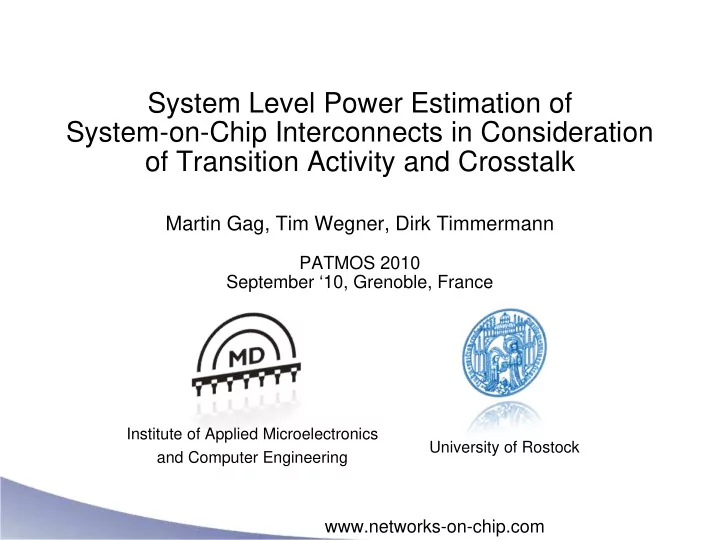

System Level Power Estimation of System-on-Chip Interconnects in Consideration of Transition Activity and Crosstalk Martin Gag, Tim Wegner, Dirk Timmermann PATMOS 2010 September ‘10, Grenoble, France Institute of Applied Microelectronics University of Rostock and Computer Engineering www.networks-on-chip.com
Outline Motivation and Basics High Level Power Estimation of Interconnects Dynamic power consumption and Crosstalk Data stream analysis Results Conclusion / Outlook www.networks-on-chip.com 2
Motivation Performance Energy Reliability Energy estimation is needed in every design step to meet constraints of all three aspects www.networks-on-chip.com 3
Basics – Energy in NoCs NoC: IP-Core, Router, Link Energy Estimation of IP-Core Router Link www.networks-on-chip.com 4
Dynamic power consumption and Crosstalk Link -> Wires R, L, Capacitances (ground, top, fringe, coupling ) Crosstalk: If wire i is driven from 0 to 1, Miller Coupling Factor (MCF) depends on changes of i+1 and i-1: 0 → 0 0 → 1 1 → 0 1 → 1 0 → 0 2 1 3 2 0 → 1 1 0 2 1 1 → 0 3 2 4 3 1 → 1 2 1 3 2 www.networks-on-chip.com 5
Data Stream Analysis Data stream based estimation tool Summing up transitions and MCFs of each bit in each word Getting signal statistics and energy estimations Using different data (video, music, text, random) 1010 Tracing signals of a H264 SOC (system verilog design) 1110 0010 to obtain signal statistics 0110 1101 1100 0100 Counting Transitions 1011 Counting MCF (Crosstalk) www.networks-on-chip.com 6
Energy Estimation Comparison of three estimation techniques Set 50% transition rate (relates to random, uniform) Measure the actual transition rate of real data Actual transition rate and add crosstalk effects (DSM Bus Model) www.networks-on-chip.com 7
Results Estimation examples: Energy consumption in relation to real transition rates including crosstalk effects Data Transition 50% activity rate Worst Case -31% -65% Random +2% +3% JPEG +1% +2% BMP +2% +127% Unenc. Video +2% +433% Average Traffic +6% +85% in H264 Decoder www.networks-on-chip.com 8
Results 50 % switching probability www.networks-on-chip.com 9
10 www.networks-on-chip.com Results
Conclusion Knowledge of data or at least its statistics is very important for energy estimation Positive and negative crosstalk effects compensate each other -> no crucial influence Dynamic energy consumption on links depends highly on matching between signal and link width www.networks-on-chip.com 11
Outlook Include the link energy estimation technique in high level architectural simulations Add energy model of routers to complete NoC-Model Add Transition and Crosstalk Avoidance Codes into simulation environment www.networks-on-chip.com 12
Recommend
More recommend